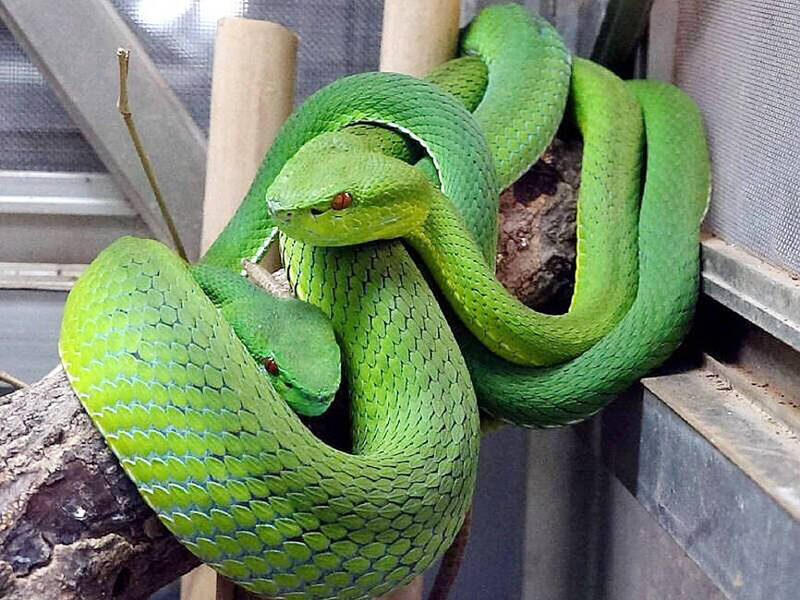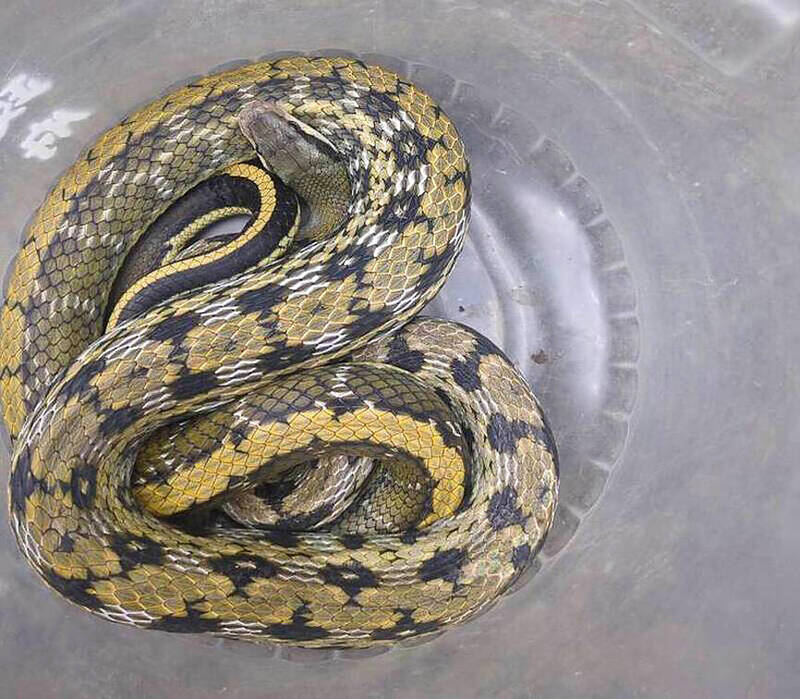《TAIPEI TIMES》 FEATURE: MOA promotes nation’s snakes in new year

Chinese green tree vipers hang on a branch in an undated photograph. Photo courtesy of Taipei Zoo
PRECAUTIONS: Although most people do not encounter snakes in their daily lives, if bitten, a person should stay calm and try to remember the snake’s markings, the MOA said
By William Hetherington / Staff writer
Wednesday was the first day of the Year of the Snake, an animal with special attributes in Chinese culture, but beyond the Chinese zodiac, Taiwan is home to many types of the limbless reptiles.
In Chinese lore, the snake symbolizes wisdom, dexterity and charm, but knowing how to discern different species of snake is a useful skill — particularly as some are venomous, the Ministry of Agriculture (MOA) wrote on Facebook.
Taiwan’s diverse natural environment has given rise to a rich variety of native snakes, with the six most common types being the Chinese cobra, the Chinese green tree viper, the many-banded krait, the beauty rat snake, the king rat snake and the Oriental rat snake, it said.
The snakes — which mostly feed on insects, mollusks, birds, amphibians, reptiles and small mammals — are essential to maintaining Taiwan’s ecological balance, but some are threatened or endangered due to human activity or past attempts to eradicate them.
While the vast majority of snakes in Taiwan are nonvenomous or only slightly venomous, and do not pose a high threat to humans, some — such as the many-banded krait and hundred-pace snake — are highly venomous, and their bites require medical treatment, it said.
One of Taiwan’s venomous snake species is the Chinese cobra, which can be found in Lienchiang County (Matsu), and all throughout Taiwan proper at altitudes below 1,000m, particularly in southern parts of the nation.
They are most commonly found in the plains, on farmland and in forests, but occasionally enter residential areas.
When a cobra is threatened or disturbed, it quickly raises the front half of its body and flares its hood. It would also make a loud hissing sound before attacking.
Conversely, the beauty rat snake, a nonvenomous and docile snake, is found in low and medium-altitude areas below 2,000m across Taiwan proper, the ministry said.
It is characterized by a black longitudinal band extending backward from behind each of its eyes, two longitudinal yellow stripes on the back of its posterior segment and regular black diamond-shaped spots on its front segment.
This subspecies is endemic to Taiwan and is the second-most common snake on Taiwan proper, the ministry said, adding that it is mainly active during the day and can be found in grasslands, forests, the lowland areas of the mountains, and around residential areas.
The Chinese green tree viper is another venomous snake, and is responsible for the majority of human bites in the country, it said.
It is widely distributed in low-altitude areas below 2,000m throughout Taiwan proper, and on Taitung County’s Green Island (綠島) and Orchid Island (Lanyu, 蘭嶼). It can be identified by its bright green color, vertical pupils, brick-red tail end, triangular head and white lines that follow the length of its body.
While the Chinese green tree viper is not a particularly aggressive snake, it will bite if provoked or disturbed, and is responsible for the majority of human bites in Taiwan, the ministry said.
As its body is the same color as many plants, farmers and field workers often fail to notice them, and disturb the reptiles while they are resting, resulting in bites, it said.
Its venom contains hemorrhagic toxins, and the bite wound would swell and bleed.
Ministry officials said that people should not to panic or drive away Chinese green tree vipers encountered in the wild.
The snakes can be found almost year-round, and are most often seen following heavy rainfall.
The king rat snake is a nonvenomous species that uses constriction to kill its prey. It is found throughout Taiwan, and can be identified by white and black spots along its body. The snake is named for the shape that forms on the heads of adults that looks similar to the Chinese character for “king.”
The king rat snake has a reputation among farmers for the large number of rats it consumes, the ministry said.
It is often found in grasslands, rice fields and farmhouses. In Taiwan, the snake is often referred to as the “stink snake,” due to its well-developed anal glands that emit a strong foul odor.
The many-banded krait is among the most venomous land snakes in the world.
It has a round head, wide black links, and hexagonal scales in the center of its back, and is found in forests, bamboo forests, swamps and near homes below 1,000m above sea level throughout Taiwan, Kinmen County and Matsu, the ministry said.
Its body is made up of wide black rings and narrow white rings. Although its venom is highly toxic to humans, it is not an overly aggressive snake, and would only attack if threatened or provoked, it said, adding that if disturbed, the snake would flee quickly or coil its body into a figure eight and bury its head under its body.
Like other species of rat snake, the Oriental rat snake is nonvenomous and is best known for its role in controlling rat populations, it said.
It is widely distributed in areas below 1,500m above sea level, in Taiwan proper, and Kinmen and Matsu. It is identifiable by its large eyes and the black rings around its eyes. It is the most common snake species on Taiwan proper and can be found in forests, farmland and wetlands, and is occasionally seen in residential areas.
The adult Oriental rat snake tends to be aggressive and moves quickly, and when provoked will hiss, raise its head and puff up its neck. It feeds mainly on mice and is the most powerful natural predator of rodents in Taiwan.
In most cases, people would not encounter snakes in their daily lives, but if a person does, they should remain calm, the ministry said.
“If you are unfortunate enough to be bitten by a snake, remember the snake’s appearance, keep the wound below the heart, avoid cutting the wound or using your mouth to extract the venom, and seek medical assistance as soon as possible,” it said.
“When hiking or engaging in outdoor activities at night, you should wear long sleeves, long pants and closed shoes. Avoid shorts, sandals and other clothing to reduce the risk of an accidental snake bite,” it said.
Snakes are an important part of the ecosystem, and their peaceful coexistence with humans helps to ensure the sustainability of natural resources, it said.
新聞來源:TAIPEI TIMES

A beauty rat snake is pictured in an undated photograph. Photo courtesy of the Nantou County Fire Bureau

A king rat snake is pictured in an undated photograph. Photo courtesy of the Changhua County Fire Bureau

A many-banded krait is pictured in an undated photograph. Photo courtesy of the Nantou County Fire Bureau

Two Oriental rat snakes are pictured in an undated photograph. Photo courtesy of Taipei Zoo

























